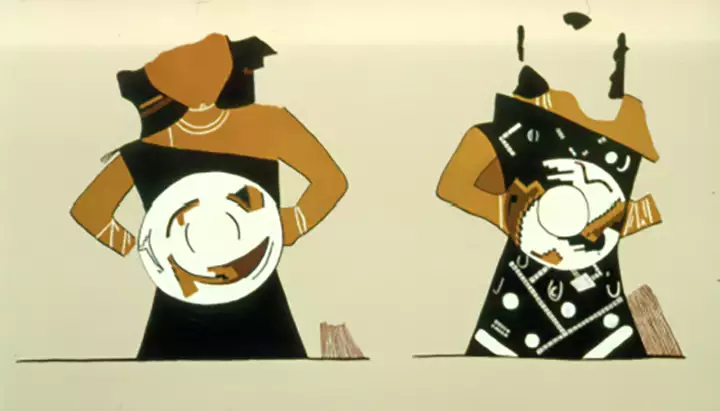Pottery Mound

Mural found in Kiva 2, Layer 2, South Wall
Pottery Mound got its name from all the pot sherds littering the place. Pottery Mound has the largest variety of prehistoric pottery styles and designs found in any one place in all of New Mexico. But the most amazing thing found at Pottery Mound was in the buried kivas: layers of well-preserved painted wall murals in more than a dozen different kivas and more than a dozen different styles of design.
As a pueblo, construction of the village began around 1320. The site was just above the flood plain of the Rio Puerco in central New Mexico. Located on the boundary between the Mogollon and Ancestral Puebloans, Isleta was to the east, Laguna to the northwest, Acoma and Zuni to the west.
The time was a period of great movement in the southwest. The weather was changing and the people were undergoing a series of migrations and cultural contractions complicated by religious clashes, community struggles and language barriers. Large areas of the countryside were being vacated by the sedentary Puebloans and the nomadic Utes, Apaches and Diné came in almost right behind them.

Mural found in Kiva 7, Layer 3, West Wall
During its ~230-year lifetime, Pottery Mound would see migrations from Acoma and Zuni overlapped by migrations from the Hopi mesas. There was some pottery imported from those locales but most pottery found at Pottery Mound was produced at Pottery Mound. On the other hand, a lot of Pottery Mound pottery has been found at locations all across the southwest, too. But in the excavations at Pottery Mound, one section of the pueblo had significantly more Acoma and Zuni design vocabulary than any other while at another section of the pueblo, that was true about Tusayan (Jeddito black-on-yellow) design vocabulary. There are also significant amounts of Rio Grande Valley pot sherds scattered around the ruins.
The wall murals were distinctly different. My trail led me to Pottery Mound because of specific wall murals. Those wall murals make it look like what we now call "Sikyátki-style" was developed at Pottery Mound and made its way to Kawaika'a, Awatovi and Sikyátki in the mid-to-late-1400s. The same style was also produced at Zuni and on the Little Colorado about the same time. By 1500 it had died out pretty much everywhere except Sikyátki, and even there there wasn't a lot being produced.

Mural found in Kiva 2, Layer 3, West Wall
One remarkable thing about the wall murals at Pottery Mound is they showed the garments worn by the ritual specialists involved in whatever rite was being pictured. The distinctly Sikyátki styles were part of the designs on the textiles and on carpets and other fabrics shown. Some of that artwork was transported to Sikyátki on pottery and it survived on that media. Some of it made the journey painted on textiles and while the designs may have been transferred to kiva walls, the wall paintings and the textiles did not survive long. Whatever ritual was involved, the last Sikyátki-style wall mural was painted at Awatovi around 1450 and that kiva was closed before 1500. The painted works at Pottery Mound were much more refined but Pottery Mound was also in serious decline by 1500 and was gone around the time Coronado arrived. If we look at it as an artist colony, some of the designs originally developed at Pottery Mound are still being replicated more than 500 years later.

Mural found in Kiva 16, Layer 1, East Wall
Pottery Mound could also have been a spiritual center where a new potential clan was being birthed. There are several other contemporaneous ruins along the Rio Puerco in the vicinity of Pottery Mound but none show any semblance of the art that developed at Pottery Mound.
Sites of the Ancients and approximate dates of occupation:
Atsinna : 1275-1350
Awat'ovi : 1200-1701
Aztec : 1100-1275
Bandelier : 1200-1500
Betatakin : 1275-1300
Casa Malpais : 1260-1420
Chaco Canyon : 850-1145
Fourmile Ranch : 1276-1450
Giusewa : 1560-1680
Hawikuh : 1400-1680
Homol'ovi : 1100-1400
Hovenweep : 50-1350
Jeddito : 800-1700
Kawaika'a : 1375-1580
Kuaua : 325-1580
Mesa Verde : 600-1275
Montezuma Castle : 1200-1400
Payupki : 1680-1745
Poshuouingeh : 1375-1500
Pottery Mound : 1320-1550
Puyé : 1200-1580
Snaketown : 300 BCE-1050
Tonto Basin : 700-1450
Tuzigoot : 1125-1400
Wupatki/Wukoki : 500-1225
Wupatupqa : 1100-1250
Yucca House : 1100-1275